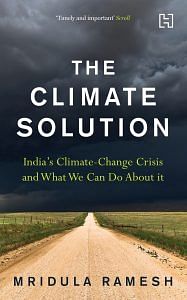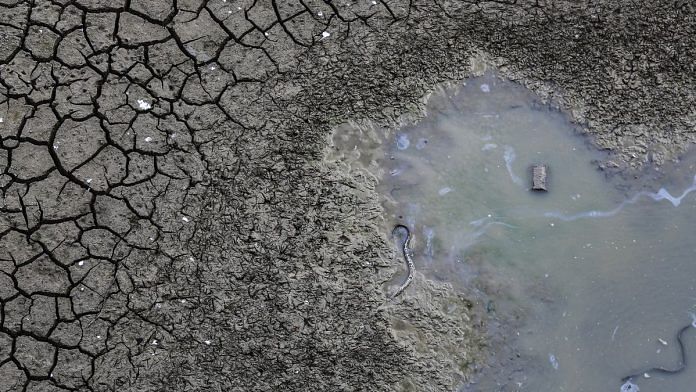The ongoing tragic Syrian crisis provides a frightening case-in-point of what can happen as more countries face water shortages. This is particularly relevant for India, because India is committing many of the same mistakes that the Syrian government made.
Peter Gleick has written an excellent paper underscoring the connection between climate change and the Syrian crisis. Syria is a very dry country, receiving about 250 mm of rain per year. To provide some perspective, India receives more than four times that number. With so little rain, Syria relies heavily on water from other sources like the Euphrates river and groundwater.
The problem began as Syria’s population skyrocketed – from 4.5 million in 1960 to over 21 million in the next 50 years. This meant that even after extravagantly using their groundwater, there was less water to go around for each person.
The problem worsened when Turkey built the Ataturk dam across the Euphrates river in the early 1990s. Damming the Euphrates reduced the amount of water flowing into Syria by a third. Rising populations combined with falling water availability meant the amount of water available for each person shrank to less than 900 cubic metre of water per person per annum – well below what hydrologists define as scarcity.
This meant one thing: Syria had essentially no wiggle room when the climate began to change. And the climate did change. The frequency and severity of droughts in the Mediterranean region have increased in the past 30 years, in line with the effects of climate change. From 1900 to 2005, Syria experienced six major droughts. Five of these lasted just a season, while the sixth lasted for two seasons. The latest drought, however, changed all that. The severe five-year drought that began in 2006 has been called ‘the worst long- term drought and most severe set of crop failures since agricultural civilizations began in the Fertile Crescent many millennia ago’.
Also read: It’s not just Chennai, India’s drying lakes crisis has spread far and wide
The drought by itself need not have translated into crop failures and food shortages. As we shall see later, Syria’s neighbour Israel also fell prey to the same drought. But while Israeli farmers thrived, Syrian farmers were decimated.
What happened? Government policy played a major role in architecting Syria’s problem, by encouraging poor crop choice – cotton and wheat, and propagating wasteful irrigation methods. Syrian farmers relied on extravagant flood irrigation and about half of their irrigation systems depended on groundwater. As the amount of rainfall decreased, farmers used their groundwater more and levels began to fall. As water levels fell, it became more expensive to draw out the water that remained until, finally, water wells began to run dry. In 2005, the Syrian government put a ban on drilling wells, but widespread corruption meant that the ban was not uniformly enforced.
There is a chilling quote in the Gleick paper that speaks of the authority’s relationship with the farmers who ‘are suffering and complain that they have had no help from the authorities who tell them what type of crops they have to plant, and have a monopoly on buying up what they produce.’ When poor water policy met with extreme climate change, the result was tragedy.
The UN sent staff to see how to help. The chosen representative, Abdullah bin Yehia’s note on what he found makes for disturbing reading: ‘The UN Interagency mission estimates that some 2,04,000 families (around one million people) in north-eastern Syria are food insecure…the needed assistance is far beyond the Government capacity and resources…many herders have incurred huge losses that they might not recover from for several seasons to come… Migration of rural population towards less water stressed urban areas was in 2007/2008 higher by 20–30 per cent than in the previous years due to impact of the drought, loss of livelihoods and water shortages.’
This cable by Yehia, calling the situation a ‘perfect storm’ was written in 2008. The report spoke of families who had lost everything, crop yields dropping to less than half of the long-term average, families selling livestock at a third of their fair price, diarrhoea, malnutrition, the works.
Also read: We are only beginning to grasp how much IS looted from Syria. And it’s a lot
A report from WikiLeaks (Cable 08DAMASCUS847_a) says that the UN representative asked for about $20 million to assist roughly one million people for six months. That’s $3.4 per person, or about `200 per person per month. A bargain, one would think – but one met with relative indifference from the global community.
This indifference was the spark that ignited the tragedy into violence. Another release from WikiLeaks, of a despatch from the US Embassy in Damascus acknowledges the UN appeal and mentions that ‘this social destruction would lead to political instability, Yehia told us.’ The cable, however, then goes on to say that ‘given the generous funding the US currently provides to the Iraqi refugee community in Syria…we question whether limited USG resources should be directed toward this appeal.’
Millions fled to crowded urban centres such as Aleppo because there was no other place to go. ‘Farmers could survive one year, maybe two years, but after three years their resources were exhausted. They had no ability to do anything other than leave their lands,’ says Richard Seager, professor at Columbia University’s Lamont-Doherty Earth Observatory. The people who lost their crops and farm animals left for the cities with next to nothing. All told, about 1.5 million people moved to cities and urban camps. Disillusionment because of lost livelihoods combined with large groups of unemployed young men congregated in crowded urban camps make for an incendiary mixture, that provided kindling for the Syrian uprising and later acted as ripe breeding grounds for ISIS.
Reading about this in 2018, it seems almost ludicrous for the seeker of relief to have been denied the $20 million request. The US government has spent more than a hundred times that amount fighting the ISIS in less than a year leading up to May 2015. By 2016, more than 4.8 million Syrians had fled their country, while the migration crisis was on everyone’s lips and votes. It became the bogeyman used by politicians to rile up their conservative support base. This is one ‘what might have been’ that policymakers around the world should be paying close attention to – the importance of one’s own actions while the climate warms.
In the next years, many parts of the world will become less liveable and, in extreme cases, inhospitable to human life. What does the world expect those living there to do? Keel over and die? That’s an unfair ask and is unlikely to get the desired response. Consider the following scenarios and questions.
First, large masses of people, travelling not in flimsy rubber dinghies in the dead of night but in armed ships in the light of day, would move to cooler countries. Some hot and dry countries possess nuclear arms. They cannot be stopped easily. Before you dismiss this as hogwash, consider for a moment that the north-west part of the Indian subcontinent could see water availability plummet and temperatures rise by 5°C in this century. Pakistan is India’s neighbour – sharing India’s fate geographically and climatologically. What do you think will happen here?
Bangladesh is slated to be one of the global hotspots affected by climate change. Rising seas, flooding, storms (coupled with unwise groundwater choices) will all contribute to yet another storm in India’s backyard.
South Asia is projected to see an internal migration of 35.7 million people on average by 2050, if we continue with business as usual. These migrants are projected to leave Bangladesh, the northern Indo- Gangetic plains, the corridor between Delhi and Lahore, and coastal regions such as Mumbai, Chennai and Dhaka. Where will they head to? In India, for instance, Bengaluru and interior Chennai are two ‘in-migration’ hotspots, but are these places capable of housing millions more?
 Excerpted with permission of Hachette India from The Climate Solution: India’s Climate-Change Crisis and What We Can Do About It by Mridula Ramesh. Paperback Rs. 399.
Excerpted with permission of Hachette India from The Climate Solution: India’s Climate-Change Crisis and What We Can Do About It by Mridula Ramesh. Paperback Rs. 399.
Also read: Why Sri Lanka became a target for Islamic State after defeat on Iraq-Syria turf







Absolutely bullshit
The analysis is a whole new dimension to discuss. But clearly, you’ve failed to show that the climate change was a contributing factor in the Syrian crisis.
We should also be aware of the fact that external countries helped to shape the current situation through armament of a specific community in Syria. And we know for a fact, people who have guns, tend to use it more frequently on order to guard their interests. And the rest of the people will become a mere fodder for those people.
Grim prognosis. Niti Aayog should be thinking deeply about these imminent problems.